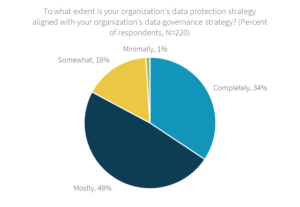What’s the State of Data Governance and Empowerment in 2021?

erwin by Quest just released the “2021 State of Data Governance and Empowerment” report. Building on prior research, we worked with Enterprise Strategy Group (ESG) to understand how organizations are defining, adopting and prioritizing data governance, as well as to examine the current drivers and challenges of governing data through its lifecycle and integration points.
It’s safe to say that the world looks a lot different than it did just 15 months ago. Today, data needs to fuel rapid decisions that make an organization more effective, customer-centric and competitive. That was true before COVID-19, and it’s even more important in the face of the radical disruption it’s caused.
As a matter of fact, according to the report, 84% of organizations believe their data represents the best opportunity for gaining a competitive advantage during the next 12 to 24 months.
This past year also saw a major shift as the silos between data governance, data operations and data protection diminished, with enterprises seeking to understand their data and the systems they use and secure to empower smarter decision-making.
Highlighting this shift, 82% of organizations have mostly, if not completely, aligned their data governance and data protection strategies, with 55% of survey respondents citing “data protection” as the term they most closely associate with data governance. Additionally, 85% monitor their databases and other data systems as part of their data governance programs. Furthermore, nearly three-quarters reported a need to dramatically improve data infrastructure.

What else did we learn?
Data Governance Definition Varies
There is still no consensus on how to define data governance. When asked for a definition, the two most popular responses were:
- Building a set of policies that governs data.
- Ensuring data usage follows defined rules.
While neither of these answers are wrong, they continue to illustrate that there’s no standard definition.
At erwin, we define data governance as helping organizations establish a sound yet flexible framework for awareness of and access to available data assets, guidance on their use, and guardrails to ensure data policies and best practices are followed.
A New Level of Maturity
When asked “how mature is your data governance program/what stage are you in,” 42% of organizations said they’ve fully implemented data governance.
That’s in sharp contrast to our last study that showed 38% of data governance programs were a work in progress and 31% were just getting started.
So it appears that enterprise data governance programs have indeed reached a new level of maturity, but the majority (58%) say their data governance programs are evolving. However, if we’ve learned anything, isn’t it that data governance is an ever-evolving, ever-changing tenet of modern business?
Key Bottlenecks and Challenges
We explored the bottlenecks and issues causing delays across the entire data value chain.
Thematically “data quality” is at the heart of desired data governance outcomes, challenges and bottlenecks, pointing to its overall importance.
Finding, identifying and harvesting data assets, the performance of systems where data is stored, documenting end-to-end data lineage, and visibility into mechanisms to protect data round out the top five obstacles to achieving optimal data value.
These are largely consistent with what we learned in our last study, with data system performance and protection making their debut this year as highly relevant problems to address.
With regard to challenges, respondents cite data quality and accuracy, skills shortages/gaps, cost, cultural change and operationalizing data governance – making it a working reality as opposed to a concept – as the top issues to address in maximizing data governance ROI.
Interestingly, 5% said they have no challenges – wouldn’t we like them to share their rose-colored data governance glasses?
Other Key Findings
The report has a lot to unpack, but here is a snapshot of some other key findings:
Time is a major factor.
- Data stewards still spend too much time on data-related activities, including analyzing (23%), protecting (23%) and searching for data (20%).
- It takes most business users (e.g., developers, analysts, data scientists) one to two business days to receive the data they request from IT.
More automation opportunities exist.
- While 42% of organizations have some mix of manual and automated processes, 93% say there’s room to incorporate more automation into their data operations.
- In line with ensuring trust in data, data quality (27%), data integration (17%), and data preparation (14%) are the three data operations automated the most.
Self-service done right is a game-changer.
- 93% of organizations already have or plan to leverage self-service in provisioning data, showing that self-service is more important than ever.
- Seven out of 10 respondents report their organizations’ self-service data provisioning enablement has had a significant business impact.
The Path to Data Empowerment
The report validates Quest’s newly launched Data Empowerment strategy and platform that bridges the gaps between data infrastructure, security and governance initiatives to mitigate risk and unleash more value from data.
Data governance provides visibility, automation, governance and collaboration for data democratization.
As part of a Data Empowerment platform — data governance puts real-time, relevant, role-based data in context in the hands of users to optimize the enterprise data capability.
So with these solutions working in concert, you can ensure the availability of secure, high-quality data to empower everyone in your organization to be more successful – that’s a win-win for employees and the organization in accomplishing its mission.
Click here to download a free copy of the “2021 State of Data Governance and Empowerment” report.
You can also watch on-demand sessions from the recent Quest Data Empowerment Summit. It includes three unique tracks —Data Operations, Data Protection and Data Governance — with sessions about the latest trends, best practices and technologies to align these critical areas and close the gaps between your front and back office.
